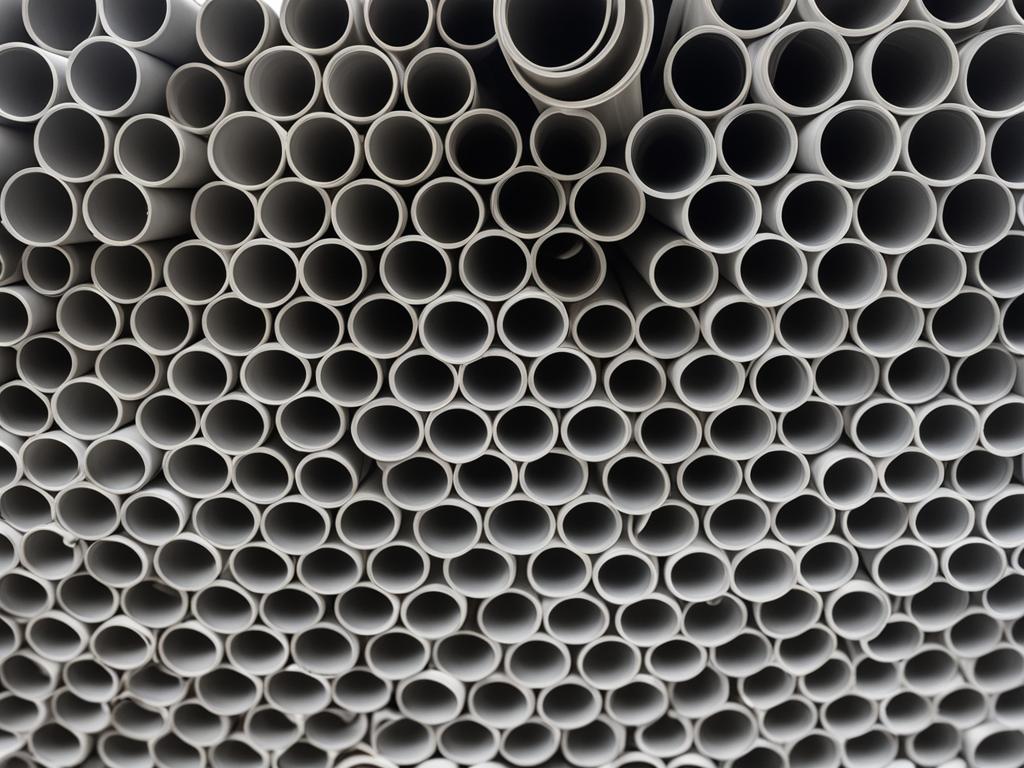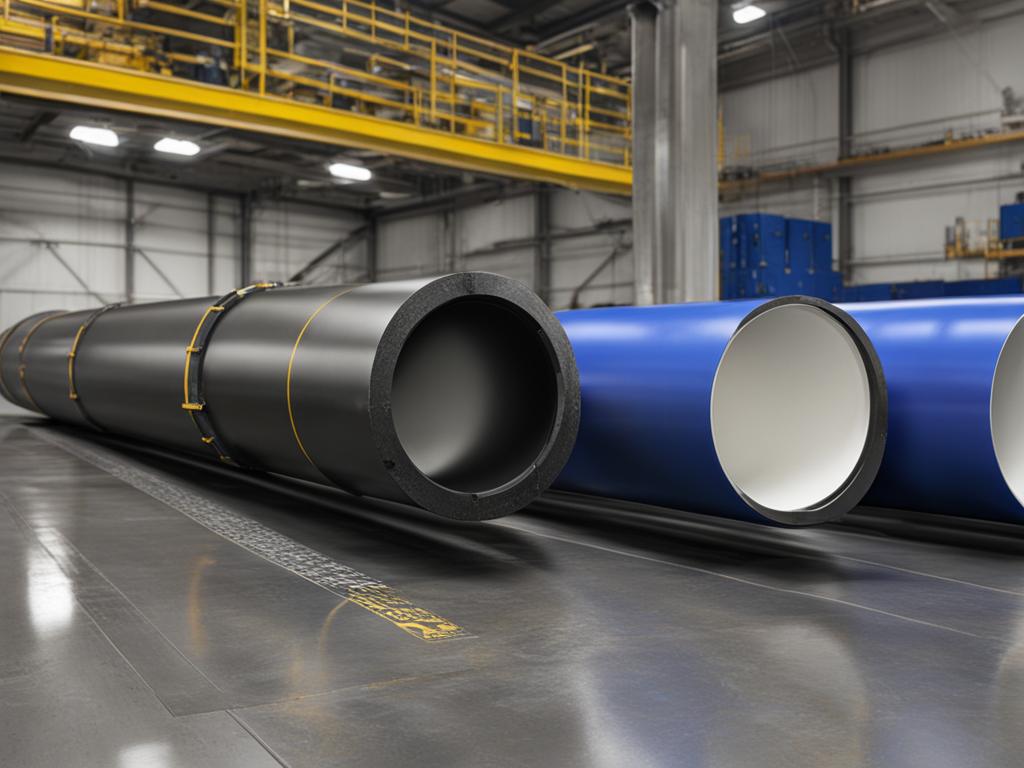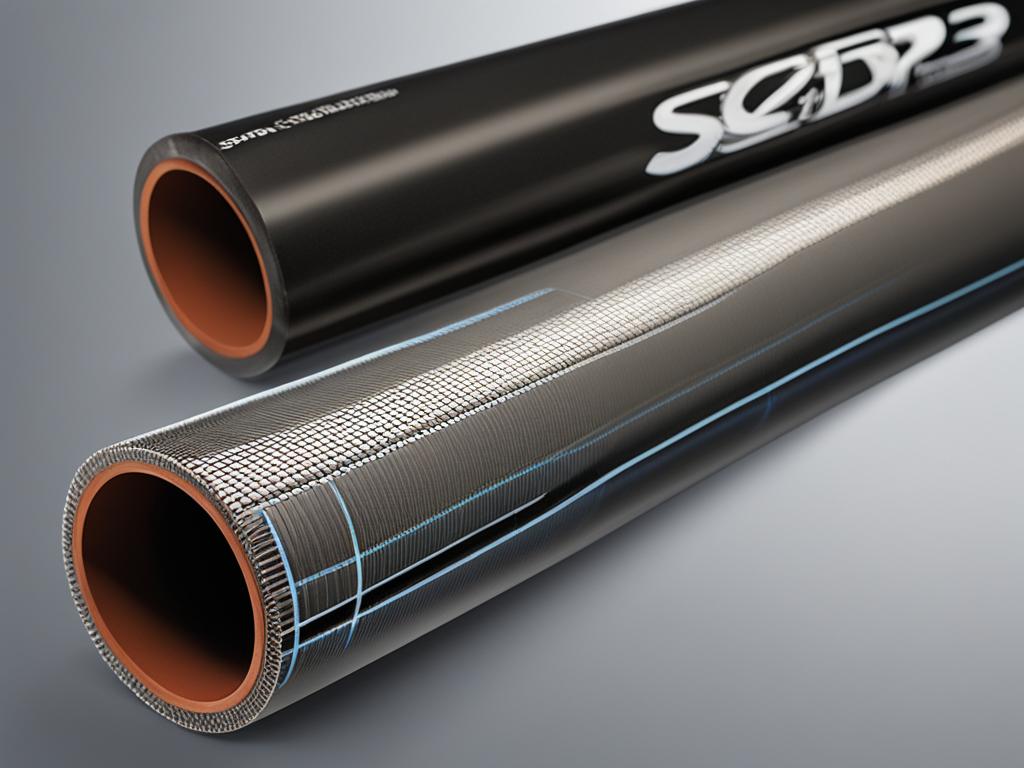When it comes to choosing the right type of PVC pipe for your project, the two most common options are SDR 35 and Schedule 40 PVC pipes. Both pipes are used extensively in plumbing, irrigation, and drainage applications, but they have different characteristics that make them more suitable for certain projects than others. In this article, we will compare SDR 35 and Schedule 40 PVC pipes in terms of their features, pros, and cons, to help you make an informed decision for your plumbing or drainage project.
Key Takeaways:
- SDR 35 and Schedule 40 PVC pipes are commonly used in plumbing, irrigation, and drainage applications.
- SDR 35 pipes are suitable for low-pressure applications, while Schedule 40 pipes are designed for high-pressure applications.
- SDR 35 pipes have smooth inner walls, flexibility, and resistance to corrosion and chemicals.
- Schedule 40 pipes are thicker, stronger, and more durable.
- Consider factors such as pressure rating, size, thickness, flow capacity, flexibility, cost, and environmental impact when choosing between the two.
Now let’s dive deeper into the specifications and differences between SDR 35 and Schedule 40 PVC pipes to help you make the best decision for your project.
SDR 35 PVC Pipes
SDR 35 PVC pipes are designed specifically for low-pressure sewer applications, making them an excellent choice for drainage projects. These pipes are made from polyvinyl chloride (PVC) resin and are known for their smooth inner walls, which reduce friction and resistance within the pipe. This feature allows for high flow rates of liquids and solids, ensuring efficient drainage.
One of the key advantages of SDR 35 pipes is their flexibility, which makes them easy to install in various configurations. Their flexibility also allows for easier adaptability to changes in ground conditions and minimizes the risk of cracking or breaking under pressure.
“SDR 35 PVC pipes are known for their smooth inner walls, which reduce friction and resistance within the pipe.”
Moreover, SDR 35 pipes exhibit excellent resistance to corrosion and chemicals, ensuring long-lasting performance and durability. Their resistance to chemical substances commonly found in soil and wastewater makes them highly suitable for underground applications.
However, it’s important to consider that SDR 35 pipes have a lower pressure rating compared to Schedule 40 pipes. This means that they are best suited for low-pressure applications. Additionally, SDR 35 pipes may be more susceptible to damage from roots and other underground obstructions, so installing them in areas prone to such issues should be done with caution.

Schedule 40 PVC Pipes
Schedule 40 PVC pipes are specifically designed to handle high-pressure applications. These pipes are thicker and stronger compared to SDR 35 pipes, which allows them to effectively withstand higher pressure and flow rates without any risk of leaking or bursting. As a result, Schedule 40 pipes are widely used in various applications such as plumbing, irrigation, and other systems that require high-pressure water or air flow.
One of the key advantages of Schedule 40 PVC pipes is their high pressure and flow capacity. These pipes are built to handle the demands of systems that require substantial pressure, making them suitable for projects that involve pumping water or air at significant force.
Moreover, Schedule 40 pipes are known for their durability and resistance to damage caused by impacts and pressure. This makes them a reliable choice for projects where the piping system may be subjected to external forces or heavy loads.
However, it’s important to note that Schedule 40 PVC pipes are less flexible compared to SDR 35 pipes. This can make the installation process slightly more challenging, especially in situations where the pipes need to be maneuvered through narrow spaces or tight corners.
Additionally, Schedule 40 pipes tend to have a higher cost compared to SDR 35 pipes. Due to their thicker and stronger construction, these pipes are generally priced higher. However, the added strength, durability, and pressure-handling capabilities of Schedule 40 pipes may justify the higher cost for certain projects.
To help you understand the differences between SDR 35 and Schedule 40 PVC pipes more clearly, here’s a detailed table comparing their characteristics:
| Characteristics | SDR 35 PVC Pipes | Schedule 40 PVC Pipes |
|---|---|---|
| Application | Low-pressure sewer systems, drainage | High-pressure plumbing, irrigation |
| Flexibility | High | Low |
| Thickness | Thinner | Thicker |
| Pressure Rating | 35 psi | 140 psi or higher |
| Cost | Lower | Higher |
| Resistance | Corrosion and chemicals | Impacts and pressure |
This table provides a comprehensive overview of the contrasting features and applications of SDR 35 and Schedule 40 PVC pipes. It can assist you in making an informed decision when selecting the most suitable pipe type for your specific project requirements.
Size and Pressure Rating Differences
One of the main differences between SDR 35 and Schedule 40 PVC pipes lies in their size, thickness, and pressure rating. These factors play a crucial role in determining the suitability of each type for various applications.
SDR 35 Pipes:
SDR 35 pipes are available in smaller diameters compared to Schedule 40 pipes. They are also thinner and more flexible, making them an ideal choice for projects where space is limited or where flexibility is required.
Schedule 40 Pipes:
Schedule 40 pipes, on the other hand, are larger and thicker. This allows them to handle higher pressure and flow rates without the risk of bursting. If your project involves high-pressure applications, Schedule 40 pipes are the recommended option.
Pressure Rating:
Another crucial difference is the pressure rating. SDR 35 pipes have a pressure rating of 35 psi, while Schedule 40 pipes have a significantly higher pressure rating of 140 psi or even higher. This means that Schedule 40 pipes can handle much more pressure than SDR 35 pipes, making them suitable for demanding applications.
When choosing between SDR 35 and Schedule 40 PVC pipes, considering the size, thickness, and pressure rating is essential. It ensures that the selected pipe type aligns properly with the specific requirements of your project, providing optimal functionality and longevity.

Differences in Size and Pressure Rating:
| Feature | SDR 35 PVC Pipes | Schedule 40 PVC Pipes |
|---|---|---|
| Diameter | Smaller | Larger |
| Thickness | Thinner | Thicker |
| Flexibility | More flexible | Less flexible |
| Pressure Rating | 35 psi | 140 psi or higher |
By understanding the key differences in size and pressure rating between SDR 35 and Schedule 40 PVC pipes, you can make an informed decision and select the most suitable option for your plumbing, irrigation, or drainage project.
Conclusion
In conclusion, when choosing between SDR 35 and Schedule 40 PVC pipes, it is important to consider the specific needs of your project. SDR 35 pipes are well-suited for low-pressure applications, offering smooth inner walls that facilitate excellent flow rates. They are also flexible and resistant to corrosion and chemicals. On the other hand, Schedule 40 pipes are the go-to choice for high-pressure applications, providing superior strength and durability.
When making your decision, consider factors such as pressure rating, size, thickness, flow capacity, flexibility, cost, and environmental impact. SDR 35 pipes are ideal if you require a cost-effective solution for low-pressure applications, while Schedule 40 pipes are the way to go for demanding projects that involve high-pressure water or air flow.
Ultimately, understanding the pros and cons of each type of PVC pipe will empower you to choose the right one for your plumbing or drainage project. By carefully weighing the advantages and disadvantages of SDR 35 and Schedule 40 pipes, you can ensure the success and longevity of your installation, regardless of the application.
FAQ
What are the main differences between SDR 35 and Schedule 40 PVC pipes?
The main differences include their pressure ratings, thickness, and flexibility. SDR 35 pipes have a lower pressure rating of 35 psi, while Schedule 40 pipes have a higher pressure rating of 140 psi or higher. SDR 35 pipes are thinner and more flexible, while Schedule 40 pipes are thicker and stronger.
What are SDR 35 PVC pipes used for?
SDR 35 PVC pipes are designed for low-pressure sewer applications. They are commonly used in plumbing, irrigation, and drainage systems.
What are Schedule 40 PVC pipes used for?
Schedule 40 PVC pipes are designed for high-pressure applications. They are used in plumbing, irrigation, and other applications where high-pressure water or air flow is required.
Are SDR 35 pipes more resistant to corrosion and chemicals compared to Schedule 40 pipes?
Yes, SDR 35 pipes are known for their resistance to corrosion and chemicals. They are made from polyvinyl chloride (PVC) resin, which provides excellent resistance to corrosive substances.
Are Schedule 40 pipes more durable compared to SDR 35 pipes?
Yes, Schedule 40 pipes are thicker and stronger than SDR 35 pipes, making them more durable and resistant to damage from impact and pressure.
Is it more difficult to install Schedule 40 pipes compared to SDR 35 pipes?
Yes, due to their thicker and less flexible nature, Schedule 40 pipes can be more challenging to install compared to SDR 35 pipes.
Which type of PVC pipe is more expensive?
Schedule 40 pipes are generally more expensive compared to SDR 35 pipes.
